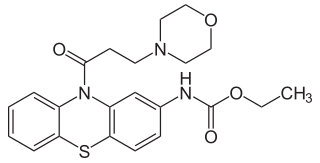In organic chemistry, butyl is a four-carbon alkyl radical or substituent group with general chemical formula −C4H9, derived from either of the two isomers of butane.

Rimantadine is an orally administered antiviral drug used to treat, and in rare cases prevent, influenzavirus A infection. When taken within one to two days of developing symptoms, rimantadine can shorten the duration and moderate the severity of influenza. Rimantadine can mitigate symptoms, including fever. Both rimantadine and the similar drug amantadine are derivates of adamantane. Rimantadine is found to be more effective than amantadine because when used the patient displays fewer symptoms. Rimantadine was approved by the Food and Drug Administration (FDA) in 1994.

Ethyl acetate is the organic compound with the formula CH3CO2CH2CH3, simplified to C4H8O2. This colorless liquid has a characteristic sweet smell and is used in glues, nail polish removers, and in the decaffeination process of tea and coffee. Ethyl acetate is the ester of ethanol and acetic acid; it is manufactured on a large scale for use as a solvent.

The Controlled Drugs and Substances Act is Canada's federal drug control statute. Passed in 1996 under Prime Minister Jean Chrétien's government, it repeals the Narcotic Control Act and Parts III and IV of the Food and Drugs Act, and establishes eight Schedules of controlled substances and two Classes of precursors. It provides that "The Governor in Council may, by order, amend any of Schedules I to VIII by adding to them or deleting from them any item or portion of an item, where the Governor in Council deems the amendment to be necessary in the public interest."

Toilet Duck is a brand name of toilet cleaner noted for the duck-shape of its bottle shaped to assist in dispensing the cleaner under the rim. The design was patented in 1980 by Walter Düring from Dällikon, Switzerland. It is now produced by S. C. Johnson & Son.
This is the list of extremely hazardous substances defined in Section 302 of the U.S. Emergency Planning and Community Right-to-Know Act. The list can be found as an appendix to 40 C.F.R. 355. Updates as of 2006 can be seen on the Federal Register, 71 FR 47121.

Antrafenine (Stakane) is a phenylpiperazine derivative drug invented in 1979. It acts as an analgesic and anti-inflammatory drug with similar efficacy to naproxen, but is not widely used as it has largely been replaced by newer drugs.

Mibolerone, also known as dimethylnortestosterone (DMNT) and sold under the brand names Cheque Drops and Matenon, is a synthetic, orally active, and extremely potent anabolic–androgenic steroid (AAS) and a 17α-alkylated nandrolone (19-nortestosterone) derivative which was marketed by Upjohn for use as a veterinary drug. It was indicated specifically as an oral treatment for prevention of estrus (heat) in adult female dogs.

ABT-239 is an H3-receptor inverse agonist developed by Abbott. It has stimulant and nootropic effects, and has been investigated as a treatment for ADHD, Alzheimer's disease, and schizophrenia. ABT-239 is more active at the human H3 receptor than comparable agents such as thioperamide, ciproxifan, and cipralisant. It was ultimately dropped from human trials after showing the dangerous cardiac side effect of QT prolongation, but is still widely used in animal research into H3 antagonists / inverse agonists.

Rosoxacin is a quinolone antibiotic indicated for the treatment of urinary tract infections and certain sexually transmitted diseases. Rosoxacin is not available in the United States.

Osanetant (developmental code name SR-142,801) is a neurokinin 3 receptor antagonist which was developed by Sanofi-Synthélabo and was being researched for the treatment of schizophrenia but was discontinued. It was the first non-peptide NK3 antagonist developed in the mid-1990s.

Vedaclidine (INN, codenamed LY-297,802, NNC 11-1053) is an experimental analgesic drug which acts as a mixed agonist–antagonist at muscarinic acetylcholine receptors, being a potent and selective agonist for the M1 and M4 subtypes, yet an antagonist at the M2, M3 and M5 subtypes. It is orally active and an effective analgesic over 3× the potency of morphine, with side effects such as salivation and tremor only occurring at many times the effective analgesic dose. Human trials showed little potential for development of dependence or abuse, and research is continuing into possible clinical application in the treatment of neuropathic pain and cancer pain relief.

Cinepazide or cinepazide maleate is a vasodilator used in China for the treatment of cardiovascular and cerebrovascular diseases, and peripheral vascular diseases. It appears to work by potentiating A2 adenosine receptors.
These drugs are known in the UK as controlled drugs, because this is the term by which the act itself refers to them. In more general terms, however, many of these drugs are also controlled by the Medicines Act 1968, there are many other drugs which are controlled by the Medicines Act but not by the Misuse of Drugs Act, and some other drugs are controlled by other laws.

Moracizine or moricizine, sold under the trade name Ethmozine, is an antiarrhythmic of class IC. It was used for the prophylaxis and treatment of serious and life-threatening ventricular arrhythmias, but was withdrawn in 2007 for commercial reasons.

Tazomeline (LY-287,041) is a drug which acts as a non-selective muscarinic acetylcholine receptor agonist. It was in clinical trials for the treatment of cognitive dysfunction such as that seen in Alzheimer's disease and schizophrenia, but development was apparently scrapped for unknown reasons. Another of the patented uses is for the treatment of "severe painful conditions".

Quingestanol acetate, sold under the brand names Demovis and Pilomin among others, is a progestin medication which was used in birth control pills but is no longer marketed. It is taken by mouth.

Ethyl cyanoacetate is an organic compound that contains a carboxylate ester and a nitrile. It is a colourless liquid with a pleasant odor. This material is useful as a starting material for synthesis due to its variety of functional groups and chemical reactivity.

EA-1763, O-PPVX, V1 or propyl S-2-diisopropylaminoethylmethylphosphonothiolate, is a military-grade neurotoxic organophosphonate nerve agent related to VX. It is part of the V-series. The substitution of a proton for methyl makes its properties more similar to those of VX.

















